
Exhibitions: Past
Experiments, Memories, and Devices
Works That Measure Amplify Connect Define
Works by Christy Georg, Richard Metzgar, and Leslie Schomp
January 28 – February 25, 2010
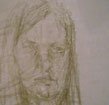
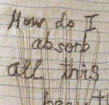
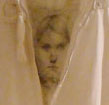

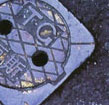

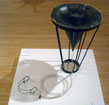
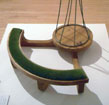
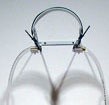
Artists are a lot like Alchemists.
They take raw materials and transform them. Whether graphite, or steel, or ordinary things like string and wax, or cigarette butts and maps, a transmutation of materials is the essence for any work of art. And in the manner of the medieval alchemists, artists have been altering materials since humans began to make objects from clay or etch marks onto stone. In a broader context, we all seek ways to tap into the creative well. Whether we plant seeds, learn about typography, follow a recipe, or examine forensic evidence, each of those events relies on assumptions about the relationships between the parts and transformation of them into something new.
Each artist in this exhibition seems to have settled upon singular, distinctly provocative ways of defining and mapping the creative process. And in so doing, each has utilized methods to connect or redefine things that we think we already know.
Kathleen Hancock
Director
The Artists
Christy Georg
I build devices which function either actually, or metaphorically. The collaboration between user and tool results in an experience/experiment; the duo act as a machine. The objects may be seen without their users; their obfuscated intentions exist as mere possibilities, in the mind. Is it any different than viewing 17th century devices, inventions and innovations far removed from our digital world in the 21st? The "present moment" has always evinced a fascinating, modern world at the height of technology. It is an uncanny thing viewed with the benefit of hindsight.
Richard Metzgar
Project Proposition
This body of work addresses a cycle of investigations on urbanism and in the everyday as a primary space of cultural experimentation. Through interventions I test and invent mediators through which to understand place and public space. Driven by a series of ongoing algorithmic walks undertaken individually and with collaborators, I have sought to capture human and nonhuman agents with photography, video, audio, and physical collections of the nonhuman and material culture (e.g., plants, rocks, water, soil, consumer detritus, etc.). What is the condition of a world that is continually inventing new modes of urban engagement? With over 60% of the world's population living in urban areas, we have crossed a threshold that clearly upsets the convention of the culture/nature dichotomy. But it also upsets the notion of a regional, national, and international identity/ies, in that these are continually shifting terms by the very nature of what passes through them/engages with them respectively. How then to understand the urban but as a multi-varied flux of transversal forces that are in continual interaction with one another. Is it possible to locate these transversal movements with an emergent practice of research that seeks a new form of engagement with the world?
Algorithm
The methodology of walking per algorithm (a simple set of directives) allows one to experiment with the world at another pace, one not guided by necessity or intuition, but by system-based movement. This practice affords one to move blindly in the world. The algorithms used to inform collection walks in Croatia, (Quebec) Canada, and Taiwan originated from environmental cues such as building addresses, signage text or letters, and taxicab identification numbers. The invented directives determined walk direction and distance, physical collection time and/or video and audio collection times, and camera orientation.
Mediators Objects and practices may be considered as mediators that are part of our everyday life. These object-mediators occur everywhere and between us - it is what allows us to be part of the world (e.g., clothing, furniture, children's toys, tools of a trade, writings, etc.). They intervene into the dialogue of re-thinking what is our relation to the "everyday" ? more mediators = more experiences in the world.
Patterns
The idea of a pattern or plan is a mediator that exists at the crux between ideas and things. Traditionally ideas can change and be revised but when a final plan or pattern is drawn everything becomes fixed and stable; at this point you just build it. The pattern closes off discussion, agency, change, etc. But if mediators are active agents in the production of reality, how can the pattern allow things to be constantly active? What do such emergent pattern systems look like? Together this body of practices and tools produce a consideration for re-thinking place as an intra-connected collective of the human and nonhuman.
Leslie Schomp
I am creating a series of stitched drawings on fabric that form a visual diary. My drawings are not a record of exact events but more an examination of relationships, roles, and moments. The drawings are stitched constantly in response to my everyday routine. I work with vintage handkerchiefs that are alternately objects of commemoration and objects that bear contact with the body. Handkerchiefs commemorate the ordinary as well as the extraordinary and represent a history of female domestic craft. My inspiration comes from my fascination with historical samplers, quilts, miniatures, embroideries, Victorian mementos and tokens of love. I also often use organic materials such as pressed flowers from my garden or hair from loved ones as they hold dual qualities of beauty and decay. They conjure up notions of humility and mortality. I respond to each handkerchief as a format for the new picture plane as well as an object that has its own material history. They often hold pre-existing stitches that carry their own history. I respond to this history in the formal choices I make for each drawing.
My work plays with a variety of stitching or ways of drawing with thread and cloth. The stitching allows line to be both physical and illusory. I make two-sided drawings as my thread envelops both sides of the fabric. Sewing allows a connection from mark to mark to be recorded on the back of the cloth. It allows me to examine my process of eye movement and thought as I draw. I draw from life as much as possible. My relationship with myself is explored by the constant act of looking at myself. The sides of each drawing are different, which allows me to explore deeper narratives and alternate aspects of each image. The work focuses on drawing as both image and object. My recent pieces have involved sewing through spaces between two handkerchiefs, working two portraits from a mirror at the same time, mapping my drawing process on the backs of each handkerchief as well as through the space between them. The act of drawing has become my content and revealing this in the final image/object is my primary goal. I also explore new ways of making marks with fabric and thread, such as pulling threads out of the cloth and playing with layers of translucency and opacity. The work has become increasingly laborious and obsessive. This act of patience has intensified the drawing process and allows me to be more sensitive to its subtleties.
Biographies
Christy Georg
Education
Massachusetts College of Art, MFA, 2003; Pacific Northwest College of Art, 1999-2000; Kansas City Art Institute, BFA, 1997
Residencies
Wurlitzer Foundation, Taos NM (upcoming); Residency Struts Gallery, New Brunswick Canada (upcoming); Residency Art 342 (upcoming); Nominee 2010 Foster Prize, Boston Institute for Contemporary Art (results pending); Residency Virginia Center for Creative Arts 2009; Residency I-park 2009; Grant Blanche E. Colman Award 2009.
Selected Exhibitions
Khyber Institute of Contemporary Art, Halifax, Nautical Body, 2010; Trustman Gallery, Simmons College, Boston, Nautical Body, 2009; Walker Gallery, Fine Arts Work Center, Provincetown, MA, Nautical Body: Part 1, 2008; Boston Children?s Museum Artist Window Installation, Ahoy, Voyager!, 2007.
Richard Metzgar
Education
Nazareth College; Rochester Institute of Technology, MFA; Syracuse University; SUNY at Purchase; Rochester Institute of Technology, BFA
Metzgar is the recipient of 5 New York Foundation for the Arts Special Opportunity Stipends and has been awarded travel grants for research in Montreal, Taipei, and Vancouver.
Selected Exhibitions
Everson Biennial (2004, 1998) at the Everson Museum of Art and at Shippensburg University, Pennsylvania School of Art and Design, Monroe Community College, Chautauqua Center for the Visual Arts, Rochester Contemporary (formerly Pyramid Arts Center), Amos Eno Gallery, Visual Studies Workshop, Pleiades Gallery, The Cooper Union, and the Memorial Art Gallery of the University of Rochester.
Collaborative Efforts
Bartow + Metzgar have created installations at Wells College, Keuka College, and Maryland Art Place among others. Forthcoming exhibitions are scheduled at Hallwalls Contemporary Arts Center, Buffalo (June 2005) and Urban Institute for Contemporary Arts, Grand Rapids, MI (October 2005).
Leslie Schomp
Education
Massachusetts College of Art, MFA, 1995-1997;Florida State University, BFA, 1990-1993
Selected Exhibitions
Essex Center of Arts, Lawrence MA, 2009; Charles City Center of Art, Iowa, February 2008; Faculty Show, Cantor Gallery, Holy Cross College, Worcester, MA , Fall 2007; Faculty Show, Emmanuel College, Boston, MA, Fall 2007; Solo ?Form Steady?, March 2004.

